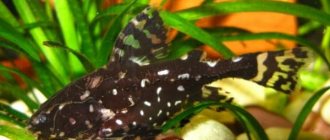Catfish Bagariy or Gunch has become a terrible legend, both among local residents and tourists. The fame of a killer fish did not come to him by chance; the predator more than once attacked people and cattle grazing along the shore. All recorded cases of giant attacks resulted in death. According to scientists, this ancient species has been preserved since the time of dinosaurs and has undergone few external changes. The size of the individual reaches up to 2 meters, sometimes there are specimens of 3 meters, and the average weight is 140 kilograms. The body is elongated, the tail and head are enlarged. The color is sandy, grayish in places, covered with dark pigmentation.
Catfish Bagarii - a dangerous predator
World record
The dispute over where the largest catfish in the world was caught continues to this day. If you believe documents and old sources, the largest catfish ever caught was from Uzbekistan. This probably happened at the end of the 19th or beginning of the 20th century. It reached a length of about five meters and weighed almost 430 kilograms, most likely this is the maximum size to which a catfish grows. Nowadays it is not easy to imagine such a monster; nowadays even fish whose size barely exceeds 20-30 kilograms have become rare. These are also quite impressive specimens, but they were not even close to that giant from the past, if you believe the archives, of course.
Catfish in a painting by Pieter Bruegel the Elder. Big fish eat little ones. 1565
Types[edit]
Currently in Bagaria
there are five to six extant species: [1]
- Bagaria bagaria
(Hamilton, 1822) (dwarf loggerhead) - Bagarius lica
Volz, 1903. - Bagarius rutilus
& Kottelat, 2000 - Bagarius suchus
Roberts, 1983 (Crocodile catfish) - Bagarius vegrandis
& Kottelat, 2021 - Bagarius yarrelli
(Sykes, 1839) (goonch) (questionably different from
B. bagarius
)
A 2021 study found that the giant devil catfish ( Bagarius yarrelli
) is a synonym of
B. bagarius
. [2]
One possible fossil species, † Bagarius gigabyte,
known from the Eocene of Sumatra. [3]
Belarusian som
| Weight: | 68 kg |
Was caught in 2011 by accident. One local fisherman and his friends decided to check the nets they had supplied earlier. When pulling up the next net, they felt a lot of resistance. It immediately became clear that the prey was serious and we needed to unite to catch it. The friends fussed with this hulk for almost an hour before they were able to pull the catfish ashore. It later turned out that the catfish weighed about 68 kilograms and its length was almost 1.8 meters. Belarusian fishermen did not refuse such a pleasant catch and later shared the caught trophy.
Goliath Tigerfish
It grows up to one and a half meters in length and weighs over 50 kg.
This fish usually does not swim alone; they gather in schools in search of prey.
In its mouth there are 32 sharp teeth, reminiscent of huge fangs (up to 5 cm long).
It lives in the African rivers of the Congo, Lualaba, and lakes Ulemba and Tanganyika.
Giant catfish from Spain
| Weight: | 88 kg |
Two years earlier, the largest catfish caught was recorded, but in Spain. In 2009, an even heavier trophy was caught on the Ebro River, but this time it was an albino. Its weight was about 88 kilograms and its length was about two meters. The fish was also pulled out by a whole group of fishermen led by a British man named Chris. The men fought with the giant catfish for more than half an hour, taking turns helping each other with the fish. After a long resistance, the fish gave up, and the fishermen themselves managed to take a great photo. After this, the monster was released back into the pond.
Record from Holland
| Weight: | 104 kg |
Was caught in one of the Dutch parks (Centerparcs). The Dutch fisherman, who was lucky enough to catch the trophy, later recalled this more than once and spoke in detail to the local media. Soma was released. At the time of capture, the underwater inhabitant had a length of about two meters and a weight of 104 kg.
After the capture of the underwater giant, the popularity of the park increased among both locals and tourists. Over the past few years, it could well have grown to even more impressive proportions. Local authorities made this catfish a real star. Its capture in the park is prohibited, and workers of the natural site carefully monitor the habitat of “Big Momma” - that’s what it was later called.
Is Goonch able to get along with other fish?
The Goonch is not a friendly neighbor and eats everything that moves nearby. No one can get along with this predator. He doesn't like his own relatives either. The presence of a pair of individuals in one place is accompanied by constant fights for territory. Keeping the catfish alone is the best option.
Bagaria catfish should be kept separately from other fish
Catfish Bagarii is considered a very dangerous fish for humans. Large rivers are of great importance in the life of local residents. They bathe in reservoirs, wash clothes, bury the dead in them, and move around. Therefore, in order not to be eaten, people actively destroy terrible giants. Nowadays, encountering the Gooncha has become a rarity; this ancient species is vulnerable to extinction.
https://youtube.com/watch?v=uBXKJTYPGJM
Huge catfish from Italy
| Weight: | 114 kg |
In 2011, another huge catfish was caught. This time the place of catch was sunny Italy. Local fisherman Robert Godey went with his friends to catch some small bream. Imagine their surprise when, instead of bream, the hook turned out to be a huge one weighing 114 kilograms and 2.5 meters long. The men tried long and hard to pull out the underwater enemy, and an hour later he was already on the shore. The Italians took a photograph and then released the predator back into the pond.
Jeremy Wade Investigation
The possibility of attack by crocodiles was ruled out because saltwater alligators did not swim that far inland, the gharial's mouth was not designed to attack people and large animals, and the marsh crocodile, which is considered the most common in India, avoided the Kali River due to its cold water. In addition, alligators have never been seen on land in these areas.
The most likely version seemed to be an attack by a bull shark, but an underwater study of the river conducted by marine biologist Rick Rosenthal showed that such fish do not live here. In addition, Wade believed that a shark attack must have been accompanied by the appearance of its dorsal fin above the surface of the water. During the research, a catfish, 1 m long, was discovered, which Wade unsuccessfully tried to catch. Thanks to the study of the river, it became clear that the supposed “man-eating fish” are found here in abundance and some of them reach human size.
After an unsuccessful attempt to catch a catfish with a fishing rod, it was decided to create a funeral pyre to test the legend widespread among local residents. The human fish turned out to be a suitable bait, and the next day we managed to catch a record gunch, almost 2 m long and weighing 75.5 kg, which was 3 times the weight of the average fish of this species. Wade theorized that this predatory catfish was large and strong enough to eat a small child. But in an interview, he officially stated that larger specimens probably exist. Wade eventually concluded that the goonch he caught was not big enough to eat people.
French catfish
| Weight: | 120 kg |
A giant from France, which, unlike previous trophies, was caught intentionally. The catch site was the Rhone River. Usatiy was caught by Yuri Grisendi, who purposefully catches river catfish. As the fisherman himself admitted, this was his hobby, and therefore it was much easier to find an approach to the next catch than for any other fisherman. The weight of the “Frenchman” reaches 120 kilograms, the size of the catfish is about 2.6 meters.
Yuri Grisendi's fishing was of sporting interest, and therefore the caught fish was released immediately after the spectacular photograph, which spread like lightning among Internet users.
Trophy from Kazakhstan
| Weight: | 130 kg |
The largest catfish live not only in the European part of the continent. In 2007, a mustachioed weighing 130 kilograms was caught in neighboring Kazakhstan. Thanks to this trophy, the Ili River has long hosted fishermen from many Western and CIS countries. The length of the catfish was 2.7 meters.
It was caught by locals who assured that it was not the only big fish. Indeed, the trophy attracted the attention of many fishing tourists, who were also lucky enough to catch similar trophies within 130 kg.
What rivers does this “monster” live in?
Sisoridae bagariidae or mountain catfishes originate from South Asia in the region of the Indian Peninsula. The giant lives in the Kali River (upper course of Gandak), which flows in the middle of India and Nepal, passing into the Ganges. Inhabits the basins of the large Indus and Brahmaputra rivers. There is information that the described species also moved to Southeast Asia. Its representatives were allegedly spotted in the Malay Peninsula basin, but there is no official confirmation of this fact.
Gunch is a freshwater fish that prefers to settle in mountainous areas of high-water, flooded rivers, with a large number of stone deposits and rapid currents. Avoids drying up and small stagnant bodies of water. Having found a comfortable place to live, it settles at the bottom, hiding among large stones and areas of rock.
Som from Poland
| Weight: | 200 kg |
Was caught on the Oder River. It is famous for the fact that a human corpse was found in the stomach. According to the forensic examination, the animal was not the cause of the person’s death. It's likely that the huge catfish found the body on the bottom and simply did what is normal in the animal kingdom - ate it. More information about the myth that the catfish is a cannibal can be found at the end of the article.
Description[edit]
Bagarius spp.
have a wide head, moderately or strongly depressed.
The mouth is wide and terminal or slightly lower. The gill openings are wide. The dorsal fin and pectoral fins have strong spines. The dorsal fin spine is smooth, and the pectoral fin spine is smooth in front and finely serrated in back. The lobes of the dorsal, pectoral and caudal fins sometimes have filamentous processes. The head and body are completely or almost completely covered with highly keratinized skin, externally differentiated into colorless plaques or tubercles.
Bagarius
species
the pectoral adhesive apparatus and the paired fins are not interlaced.[4]
Bagarius spp.
have the same general coloration, consisting of three darkly pigmented stripes or spots on the body.
Irregularly located spots may also be present on the body. Fin pigmentation varies from species to species, from plain to spotted to slightly or heavily striped. [4] Additionally, some B. yarelli
may have a heavily spotted pattern, like the Dalmatian dog, that obscures the main barred pattern. [4]
In B. bagarius
the origin of the pelvic fin is usually anterior to a vertical line passing through the base of the last ray of the dorsal fin, whereas in
B. yarelli
the origin of the pelvic fin is behind this vertical line.
Additionally, in most B. bagarius
the adipose fin begins well behind the anal fin, on a vertical line passing through the base of the third or four rays of the anal fin.
However, in most B. yarelli
the adipose fin begins near or in front of a vertical line passing through the origin of the anal fin.
In B. suchus
the adipose fin originates even further back than in
B. bagarius
or
B. yarelli
.
B. suchus
has a flatter head and body than
B. bagarius
or
B. yarelli
. [4]
B. bagarius
does not grow much taller than 20 centimeters (7.9 in) SL.
[4] B. rutilus
grows to approximately 100.0 cm (39.4 in) SL.
[7] B. suchus
grows to approximately 70.0 cm (27.6 in) SL.
[8] B. yarelli
grows very large, reaching approximately 200 cm (78.7
in
) SL. [4]
The largest catfish caught in Russia
| Weight: | 200 kg |
Huge catfish are also found in our Russian reservoirs, and not only in Europe and Asia. For example, fishing for large catfish in river basins is most often mentioned:
- Volga;
- Don;
- Dnieper;
- Amur;
- Okie;
- Dnieper;
- Akhtuby.
We are talking about a huge catfish, whose weight exceeded 200 kilograms. This largest catfish caught in Russia was lucky enough to be caught in the Kursk region on the Seim River in 2009. The underwater hunters noticed a huge fish and, without being confused, fired a shot from an underwater gun, which turned out to be quite accurate and professional.
They tried to pull him out of the water, but they couldn’t do it on their own. The hunters turned to a local tractor driver for help, who pulled the monster ashore with a tractor. The surprise of the locals knew no bounds. According to them, they had never met catfish of this size before and could not even think that such were found in their native river.
The prospect of keeping a giant in an aquarium
Despite their large size, some aquarists keep catfish in captivity. It is quite difficult to create acceptable conditions for keeping this exotic species and leads to significant financial costs. Therefore, the giant fish is not suitable for the home aquarium and is usually reserved for large aquariums. Caring for the Bagari catfish and arranging the tank can only be done by professionals in this field. To accommodate such a pet, you have to hire a whole team of installers.
To keep one fish, the following requirements are met:
- Install an aquarium with a volume of at least one and a half thousand liters.
- Fill the container with clean fresh water; it is advisable to purchase special water for aquariums.
- Coarse sand is used as a substrate, supplemented with stones and decorative rocks.
Bagaria catfish can be kept in an aquarium, but then they are small in size - They install a powerful filtration system. Cleaning such a volume of water is difficult, and the fish also produce a large amount of waste.
- An automatic device for changing water is necessary, since it is impossible to do this manually.
- The backlight should be dim.
- Maintains a comfortable temperature range of 16-32 degrees.
- Catfish prefer current, so moderate or strong water movement is organized.
- Feeding consists of live fish, shrimp, worms, shelled mussels or frozen foods for carnivorous species.
Failure to comply with these rules for keeping a huge pet can provoke a number of pathologies in the fish. A sick Goonch becomes lethargic, does not rise to the surface, and loses interest in food.
To ensure all the conditions for keeping a giant catfish, it is necessary to establish communications and carry out a number of complex construction works. Despite the efforts of aquarists, in captivity the fish reaches smaller sizes than in the natural environment, and grows no more than a meter.
A huge catfish from Thailand entered the Guinness Book of Records
| Weight: | 294 kg |
In 2005, in Thailand, on the Mekong River, a huge inhabitant of the river was caught, the mass of which reached 294 kilograms, although the length did not exceed three meters. The news about such a large albino catfish spread instantly and soon Zeb Hogan, a representative and responsible for the international WWF project, checked the accuracy of the data, which allowed this fish to be included in the Guinness World Records list. After all the research work, they wanted to release the fish back into its habitat, but, alas, it died.
Electric eel
It lives in the Amazon River and in the rivers of the northeastern part of America.
It hunts by stunning its prey with a powerful 600-volt electric shock.
Individuals up to 3 meters in length and weighing up to 40 kg are often found.
Legendary catfish from Kyrgyzstan
| Weight: | 347 kg |
According to unofficial data, the largest catfish was caught in Kyrgyzstan on Lake Issyk-Kul. This happened at the end of the 19th century, but there is still debate about this capture. If you believe old sources, then his weight reached 350 kilograms. According to legend, an arch resembling the jaws of a catfish was installed on the shore near the place where the world's largest catfish was caught. But it has not survived to this day; the landmark has been lost.
Interesting facts about catfish
- The average size of catfish in Russia varies from 5 to 30 kilograms. Specimens of the maximum size are very rare and catching them requires luck and skill.
- Rumors about radioactive catfish living in the territory of Pripyat are partly not rumors. Background radiation is still present in those places, and therefore many inhabitants of reservoirs continue to receive radiation. Sometimes this leads to mutations, but not to supergiant sizes.
- Catfish prefer to stick to the bottom, and therefore often feed on carrion remaining on the bottom.
- They go out to feed early in the morning and late in the evening - this is the best time for fishing.
- They lead a sedentary and sedentary lifestyle, rarely leaving their “native” places.
- The catfish's whiskers attract fish by imitating the movements of worms, which serves as a trap for many.
Guinness book
Based on the results of our top, we can understand that the largest catfish in the world included in the Guinness Book is a trophy caught in the Mekong River. Many ecologists are still guessing as a result of what events the local species of catfish could gain a weight of almost 300 kilograms with a length of no more than three meters. After being caught, this catfish died almost immediately. But it's still interesting to imagine the size it could reach if it were placed back in the river.
Catfish cannibals - fiction or reality?
There is an opinion that large fish can attack a person if there is an opportunity for this. But this is not true:
- the catfish is not a hunter, but more of a scavenger;
- It is also worth taking into account the actual size of the fish - individuals exceeding 40-50 kilograms and capable of attacking a person are extremely rare;
- larger catfish live at greater depths than those used by swimmers for their own purposes;
- Human remains found in the stomachs of various catfish after a documentary examination indicated that the catfish was already feeding on a corpse and did not attack a living person.
Although cases of attack are extremely unlikely and have not been proven, you should be more careful about your time on the pond and carefully find out about local peculiarities before swimming.
Cannibal from Turkey
Back in the last century, in 1970, a catfish was caught in Turkey, the length of which reached almost two meters. A little later, fishermen decided to open his stomach and found the body of a woman there. Later it turned out that the woman drowned and only after that she was eaten by a catfish.
Lifestyle and distinctive features of Gunch
Both day and night, Gunch behaves the same. It mostly lies on the ground, rising only when it finds something edible. Despite its low activity, it is ready to attack at any time of the day. Having grabbed prey from the surface layer of water, it drags it to the bottom and then eats it.
If a person is in the path of a dangerous predator, he will not hesitate to attack, even a crowd of people nearby will not scare him away. From 1999 to 2007, several cases of Gunch attacks on local residents were established; no one managed to escape. Also in the gastrointestinal tract of a typical representative of the species, the remains of a Nazi from the Great Patriotic War were found.
The giant catfish prefers strong currents of mountain rivers, along which it migrates from time to time in search of new areas rich in food. During the rainy season, it moves long distances when rivers flood and the water becomes cloudy.
This fish can attack humans
In addition to its large size, a distinctive feature of the fish is its snout with antennae, similar to a dragon's head. This feature makes the Gunch even more terrifying.











